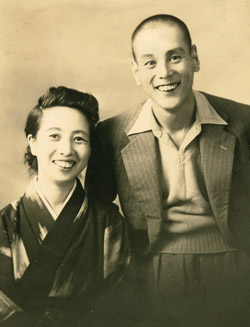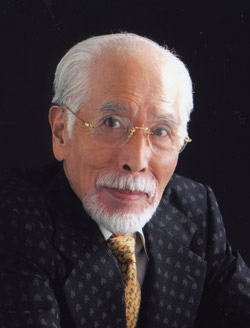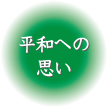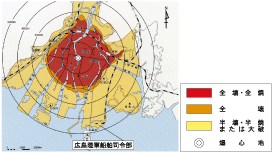The A-bomb survivors went through tragic ordeals. Suffering the pain of being ‘survivors,’ they repeatedly asked themselves if there was any mission entrusted to them by those who had died. What could they do as individuals to create a peaceful world?
Suffering from A-bomb Disease
Nekohachi Edoya

Yaeko and Nekohachi
At this time, Nekohachi was losing his hair, and his white blood cells were continuing to diminish.
Around 1946
Courtesy of Nekohachi Edoya the 4th
Nekohachi Edoya joined the Furukawa Roppa Troupe in 1940 as an actor. In 1942, he was conscripted and joined the Army. He was a security guard for a transport vessel. In the fall of 1943, his ship stopped at Ujina Port, where he was assigned to clerical work in the Ujina main unit. On August 6, 1945, Nekohachi (then, 23) experienced the atomic bombing while in a barrack at Army Marine Headquarters. As he had no severe injuries, he worked in Ujina to care for the wounded.
After the war, Nekohachi went back to Tokyo. He suffered from A-bomb disease, but never spoke of his A-bomb experience. In 1950, he succeeded to the name ‘Edoya Nekohachi the third.’ In 1955, he instantly became famous by appearing on an NHK television program called ‘The Funny Trio.’ As he gradually overcame his fears and worries about A-bomb sickness, he started to think it might be the survivors’ duty to pass on the A-bomb experience to other people. In 1981, for the first time, he spoke of his Hiroshima experience in his work entitled ‘Hiroshima Atomic Bomb Experience Records.’ He died in 2001.
“I am sorry”
Koishi Kimi
In 1940, at the age of 13, Koishi Kimi started manzai (comedy skits), slapstick and wisecracks in a comedy duo with his brother Itoshi, who was older than him by two years. As all of Japan was gradually surrounded by a wartime atmosphere, Koishi volunteered to join the Army. At the time of the atomic bombing, Koishi belonged to the Chugoku Regional Military Training Unit, and experienced the atomic bombing in a barrack just north of Hiroshima Castle. He was trapped under pillars, but was rescued. He was carried to a riverbank near Misasa Bridge, where he received emergency treatment. Then he was carried to a hospital on Ninoshima Island, which is where he was when the war ended.
After leaving the Army, he went back to Osaka. His older brother asked him to do manzai with him again, but Koishi could not feel good about doing so. He felt hesitant about going back to that career, which was basically about making people laugh, as his thoughts were with the A-bomb victims. However, he still had to make a living. In 1948 the brothers changed their name to Itoshi Yumeji and Koishi Kimi. They were popular as a real-brother manzai duo.
Koishi used to say that he was sorry to have survived; he avoided atomic bomb related subjects. He never applied for an Atomic Bomb Survivor’s Certificate. Later in life however, he gradually started to talk about his A-bomb experience to help people understand the tragedy of war. He died in 2011.

Courtesy of Wako Production Inc.
Hiroshima Army Marine Headquarters (commonly known as the Akatsuki Corps)
Masao Maruyama and Nekohachi Edoya were members of Hiroshima Army Marine Headquarters (commonly known as the Akatsuki Corps).
There were 30 units stationed at Hiroshima Army Marine Headquarters. The headquarters, which controlled and commanded the troops, were in Gaisenkan Lodge, which was located in Ujina-machi (now, Ujina-kaigan 3-chome, Minami-ku). As the headquarters were approximately 4.5km away from the hypocenter, damage was relatively light and the soldiers there immediately began rescue efforts.




